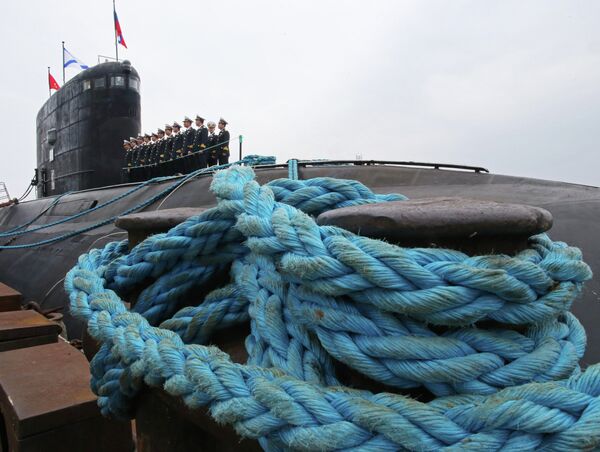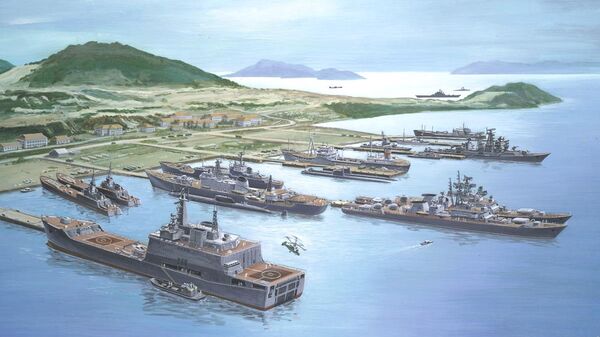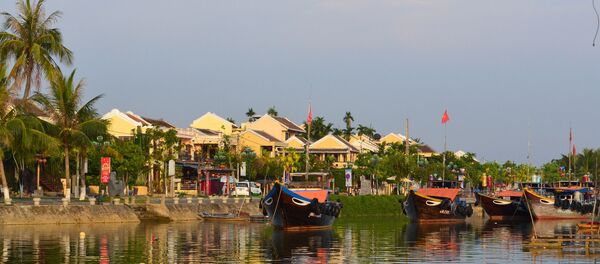Speaking to the Russian news agency RIA Novosti earlier this week, Nguyen Thanh Sean explained that "Vietnam's policy is not to enter military alliances or to ally with any one state against another."
That being said, the ambassador added that "in this context, the use of the Cam Ranh Bay port for multilateral international cooperation for the provision of maritime transport, ship repair and the development of defense technology to ensure peace and stability in the region is an appropriate direction to take."
Analyzing the diplomat's remarks, Russian journalist Anton Mardasov recalled the origins of the Soviet/Russian base at Cam Ranh Bay, and the prospects for the Russian Navy's further use of the base in an article for the independent newspaper Svobodnaya Pressa.
"It's worth recalling," the columnist wrote, "that in 1979, the Socialist Republic of Vietnam provided the naval facilities at the Cam Ranh Bay port to the Soviet Union 25 years rent-free. The Soviet military rebuilt and expanded the base. Modestly called a 'Material-Technical Support Point', the facility was actually a powerful base for the 17th Operational Squadron of the Soviet Navy."
"At any one time, the facility simultaneously hosted 8-10 surface ships, 4-8 submarines, and supply vessels. The Cam Ranh base allowed the Pacific Fleet to control the southern Pacific, and the entire Indian Ocean. In 2001, the Russian government made the decision not to renew the lease with Vietnam and to evacuate the base ahead of schedule."
Now, Mardasov noted, questions over the base have once again gained relevance, and center around the question of Moscow's readiness to reconsider its maritime role in the Asia-Pacific region. "Judging by the agreements already reached at the highest level, Moscow is ready to do so. On November 12, 2013, the presidents of Russia and Vietnam signed an agreement on establishing a joint base for the maintenance and repair of submarines at Cam Ranh."
The latest development, Mardasov noted, occurred in November 2014, when "it was reported that during his visit to Russia, Vietnamese Communist Party General Secretary Nguyen Phu Trong signed an agreement on the simplification of the procedure for Russian ships to make port calls to Cam Ranh." From that moment, Russian vessels would only have to notify Vietnamese authorities ahead of time to enter the port.
This, the journalist recalled, was a significant step, not least because Vietnam factually became only the second country after Syria with which Russia agreed on this kind of simplified procedure for its ships.
Since then, "some military experts have suggested that further agreements would soon be reached, on the reestablishment of a logistics point for the Russian Navy…Experts said that this would be facilitated by the fact that Vietnam is Russia's traditional partner in the military sphere. In recent years, the two sides have signed contracts worth over $4.5 billion dollars."

Russia has already delivered 4 of 6 promised Warszawianka-class diesel submarines equipped with the Klub-S (Kalibr) missile complex, and supplied Vietnam with the Bastion mobile coastal missile complex, along with the Gorizont geosynchronous comms satellites to go along with the system. Other Russian weapons systems ordered by Hanoi include the Molnya missile boats, Gepard 3.9 patrol frigates, and Su-30MK2 all-weather long-range strike fighters.
Asked about the prospects for further cooperation, Retired Col. Gen. Leonid Ivashov, the president of the Moscow-based Academy of Geopolitical Problems, who participated in the negotiations on Cam Ranh in 1998-2000, emphasized that the ambassador's words are "not just empty rhetoric."
"I believe that the Ambassador Nguyen Thanh Sean was not simply expressing his personal opinion. It's probable that some contacts between the two countries' militaries have already been made regarding Cam Ranh. In other words, he stated his country's official position, and it can be interpreted as an invitation which, in my opinion, we simply cannot refuse."
"Today," the officer added, "we have once again begun more actively coming out onto the world's oceans, and have our own strategic interests to defend. In this regard, our military presence in the Asia-Pacific region is essential. The question is in the price."
"Under the [1979] agreement, until 2000, Russia, the successor of the USSR, did not pay anything for this base. When the Vietnamese side raised the question of a new rental agreement for the base, the Russian delegation, which I chaired, and which would later become led by then-Defense Minister Igor Sergeyev, came to an agreement on favorable terms for our presence."
At that time, Ivashov recalled, the Russian side offered the Vietnamese Navy two of the six quays, use of the airfield for joint deployment, as well as several ships which had been decommissioned from the Soviet Navy. "And today too we have something to offer the Vietnamese: we are continuing to deliver a wide array of military equipment to the country."
At the same time, the officer said, a Russian presence at Cam Ranh would be beneficial for Vietnam for the strategic perspective: "it dramatically increases the country's security in relation to its closest neighbors, China and the United States. We should not forget that Vietnam, in spite of its limited land area, is a large country with a rapidly growing economy, and that it is catching up with Russia in terms of population."
Ultimately, Ivashov explained, "if an agreement is reached on our return, it's obvious that Cam Ranh will be a small military facility, compared to the forces that were based there during the Soviet period. But this too would be enough." In recent years, the officer emphasized, the naval base at Syria's Tartus has given Moscow a new understanding of the importance of a permanent regional presence, achieved via naval bases. "If we want to play an influential role in the world today, we need to strengthen our military presence on other continents," Ivashov concluded.
Moreover, the analyst noted, "it's not even necessary to keep ships there on a regular bases, especially considering that we could not do this even if we wanted to – we simply do not have enough ships. But maintaining the necessary infrastructure or even simply using Vietnamese infrastructure would be enough to provide for a military presence. Incidentally, the US doesn't find it necessary to keep dozens of ships at its bases abroad. Sometimes they are completely empty; the important thing is that the base exists, that US personnel serve there, that aircraft are based there and that ships can safely enter the base for refueling, resupply and repair."
Finally, Andrei Frolov, editor-in-chief of the Export Vooruzheny military magazine, told Svobodnaya Pressa that on the one hand, the discussions "about Russia's imminent return to Cam Ranh is still only talk. On the other, it is a good opportunity to return our country the status of a great power, for relatively little money."
"Undoubtedly, military facilities in the Asia-Pacific region would simplify the tasks of strategic aviation, and of warships of the Pacific Fleet, which head out to the Indian Ocean to combat piracy and conduct exercises with the Indian Navy. Still, in my opinion, a presence at Cam Ranh is not a question of paramount importance for Russia. As the saying goes, the devil is in the details: in any case, renting the base will cost money, and it's one thing if the Vietnamese demand tens of millions of dollars, and another if we can come to an agreement via barter."
Ultimately, Frolov noted, "at the moment, it's enough for Russia to be able to freely enter Cam Ranh – an agreement on this is already in place. Over the last 10 years Russia has not faced any serious [military] tasks in this region, and the ships of the Pacific Fleet (usually in the configuration of a large anti-submarine ship, a tanker and a rescue vessel) already have the opportunity to enter Cam Ranh to refuel."






